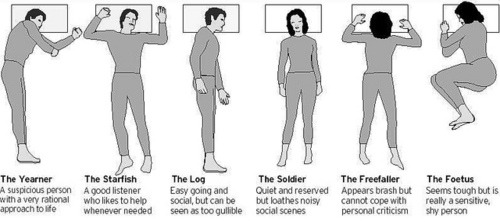10 Facts About Dreams
By Kendra Cherry
1. Everybody Dreams

Men do it. Women do
it. Even babies do it. We all dream, even those of us who claim not to. In
fact, researchers have found that people usually have several dreams each
night, each one lasting for between 5 to 20 minutes. During a typical lifetime,
people spend an average of six
yearsdreaming!
Ads
2. But You Forget
Most of Your Dreams

According to
estimates by dream researcher J. Allan Hobson, as much as 95 percent of all
dreams are quickly forgotten shortly after waking. Why are our dreams so
difficult to remember? According to one theory, the changes in the brain that
occur during sleep do not support the information processing and storage needed
for memory formation to take place. Brain scans of sleeping individuals have
shown that the frontal lobes, the area that plays a key role in memory
formation, are inactive during REM sleep, the stage in which dreaming occurs.
3. Not All Dreams Are
In Color

While approximately
80 percent of all dreams are in color, there are a small percentage of people
who claim to only dream in black and white. In studies where dreamers have been
awakened and asked to select colors from a chart that match those in their
dreams, soft pastel colors are those most frequently chosen.
4. Men and Women
Dream Differently

Researchers have
found a number of differences between men and women when it comes to the
content of their dreams. In one study, men reported more instances of dreaming
about aggression than women did. According to dream researcher William Domhoff,
women tend to have slightly longer dreams that feature more characters. When it
comes to the characters that typically appear in dreams, men dream about other
men twice as often as they do about women, while women tend to dream about both
sexes equally.
5. Animals Probably
Dream

Have you ever watched
a sleeping dog wag its tail or move its legs while asleep? While it's hard to
say for sure whether the animal is truly dreaming, researchers believe that it
is likely that animals do indeed dream. Just like humans, animals go through
sleep stages that include cycles of REM and NREM sleep. In one study, a gorilla
was taught sign language as a means of communication. At one point, the gorilla
signed "sleep pictures," possibly indicating the experience of
dreaming.
6. You Can Control
Your Dreams
 Photo by Emil
Bacik
Photo by Emil
Bacik
A lucid dream is one
in which you are aware that you are dreaming even though you are still asleep.
During this type of dream, you can often "direct" or control the
content of the dream. Approximately half of all people can remember experiencing
at least one instance of lucid dreaming, and some individuals are able to have
lucid dreams quite frequently.
7. Negative Emotions
Are More Common in Dreams

Over a period of more
than forty years, researcher Calvin S. Hall collected more than 50,000 dream
accounts from college students. These reports were made available to the public
during the 1990s by Hall's student William Domhoff. The dream accounts revealed
that many emotions are experienced during dreams including joy, happiness and
fear. The most common emotion experienced in dreams was anxiety, and negative
emotions in general were much more common than positive ones
8. Blind People Dream

While people who lost
their eyesight prior to age five usually do not have visual dreams in
adulthood, they still dream. Despite the lack of visuals, the dreams of the
blind are just as complex and vivid as those of the sighted. Instead of visual
sensations, blind individuals' dreams typically include information from the
other senses such as sound, touch, taste, hearing and smell.
Ads
9. You Are Paralyzed
During Your Dreams
 Photo by Valua
Vitaly/iStockPhoto
Photo by Valua
Vitaly/iStockPhoto
REM sleep, the stage of sleep during which dreaming occurs, is
characterized by paralysis of the voluntary muscles. Why? The phenomenon is
known as REM atonia and prevents you from acting out your dreams while you're
asleep. Basically, because motor neurons are not stimulated, your body does not
move.
In some cases, this paralysis can even carry over into the
waking state for as long as ten minutes, a condition known as sleep paralysis.
Have you ever woken up from a terrifying dream only to find yourself unable to
move? While the experience can be frightening, experts advise that it is
perfectly normal and should last only a few minutes before normal muscle
control returns.
10. Many Dreams Are
Universal
 Photo by
Abdulaziz Almansour
Photo by
Abdulaziz Almansour
While dreams are often heavily influenced by our personal experiences,
researchers have found that certain themes are very common across different
cultures. For example, people from all over the world frequently dream about
being chased, being attacked or falling. Other common dream experiences include
school events, feeling frozen and unable to move, arriving late, flying and
being naked in public.
http://psychology.about.com/od/statesofconsciousness/tp/facts-about-dreams.htm
Falling
in love is a wonderful experience, but there are so many strange psychological
facts about love too. Do you know why you blush or kiss in love? Or why
heartbreaks hurt so much?



Psychological Facts About Love
Falling
in love is a wonderful experience, but there are so many strange psychological
facts about love too. Do you know why you blush or kiss in love? Or why
heartbreaks hurt so much?

Love fact #1 Love makes us crazy
For
one thing, love causes serotonin levels in the brain to drop, which may lead
people to obsess about their lover.
The
levels of serotonin, a chemical produced by the body, are also low in people
who have obsessive-compulsive disorder.
Next,
it ramps up production of the stress hormone cortisol, leading to slightly
higher blood pressure and possible loss of sleep.
Scientists
at the University
of London
All
in all, love kind of leaves you obsessive, stressed, and blind!
Love fact #2 Broken hearts always hurt
A
new study suggests the psychological hurt of a break up is just as real as a
physical injury.
Two
areas of the brain that respond to physical pain also become activated when a
person is dealing with social or romantic pain, such as being dumped.
The
study’s authors at UCLA used an MRI to monitor brain activity in participants
while they played a game simulating social rejection.
The researchers believe that the pain of
being rejected may have evolved as a motivating force that led humans to seek
out social interaction, which is crucial for the survival of most mammals.
Love fact #3 Kiss the right way
Did
you know there is a “right” way to kiss? People are more likely to tilt their
heads to the right when kissing instead of left, says a report published in the
journal, Nature. A scientist from Ruhr
University in Germany
Love fact #4 Blushing is best
If we take our cue from apes, rosy cheeks
are crucial in the dating game, says a new study. Scientists at Stirling University
in Great Britain
A
rosy glow might also act as a similar cue in humans, say the British
researchers, sending a message of good health. They speculate that it could
explain why women use blushers.
Psychological Facts About Personality




